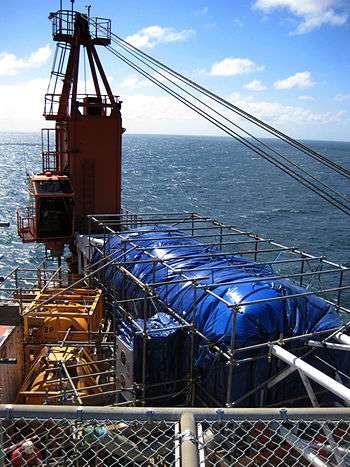Positive pressure enclosure
|
Positive pressure enclosure (blue chamber) in use on a North Sea drilling platform |
A positive pressure enclosure, also known as an isolation chamber, is a chamber used to provide a safe work environment for performing hot work in the presence of explosive gases or vapours. They are used most often in conjunction with the need for welding, and are often associated with the offshore oil industry.
A positive pressure enclosure works by providing a constant inflow of breathable atmosphere, which in turn causes gas to continuously leak out of the chamber. This outflow of gases prevents the ingress of explosive gases or vapours which are often present in such work locations. This constant outflow of gases from the chamber also serves to cleanse the air within of the undesirable gaseous by-products of the welding process. Most commercial versions of positive pressure enclosures are referred to by their manufacturers as habitats.
Operating principles
Flammability limits
Flammable gases are not generally explosive under all conditions, and indeed, must be present within specific ranges in order to be explosive, or flammable. Additionally, oxygen must be present.[1] The flammability limits of gases are expressed in proportions to the other gases present. For example, for methane, the lower explosive limit (LEL) is 4.4% and the upper explosive limit (UEL) is 17%. A positive pressure enclosure works by making sure that the methane present in the work area never approaches the 4.4% LEL.
Government regulations in the European Union and in North America define the safety requirements for workers working in the presence of flammable gases.[2] In Europe, these regulations are found in the ATEX directives, and in the United States, in the National Electrical Code.
Positive pressure
The operating pressure inside a typical isolation chamber is set only marginally above local pressure; typically only 0.05 kilopascals (about 0.007 pounds per square inch) above local atmospheric pressure. This is sufficiently low to be undetectable (a person sitting in a bathtub full of water is exposed to greater pressures) to operators working inside the enclosure, but due to the leaky nature of the unit, ensures that the volume of air inside is constantly and rapidly changing. Intake air is piped into the enclosure by fan units.
References
- ↑ The Basics of Explosion Protection, www.r-stahl.com/fileadmin/Dateien/explosionsschutz/pdf/grundlagen_en.pdf retrieved 20 October 2008
- ↑ http://www.hse.gov.uk/fireandexplosion/zoning.pdf - retrieved 20 October 2008
